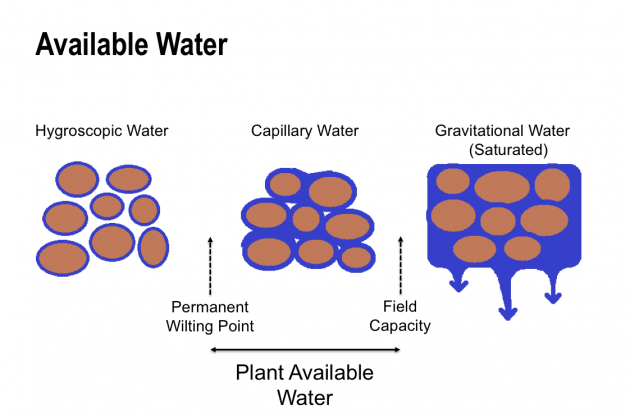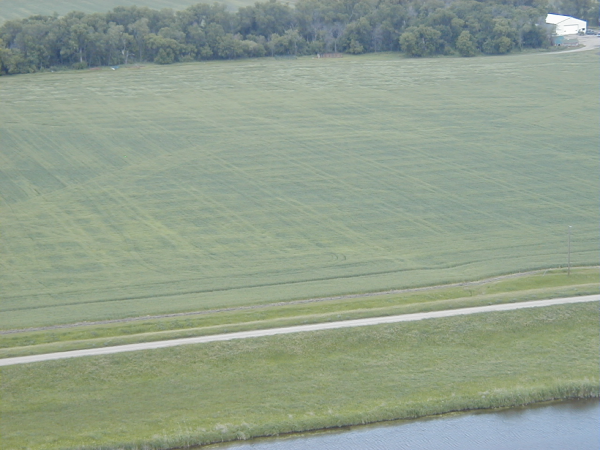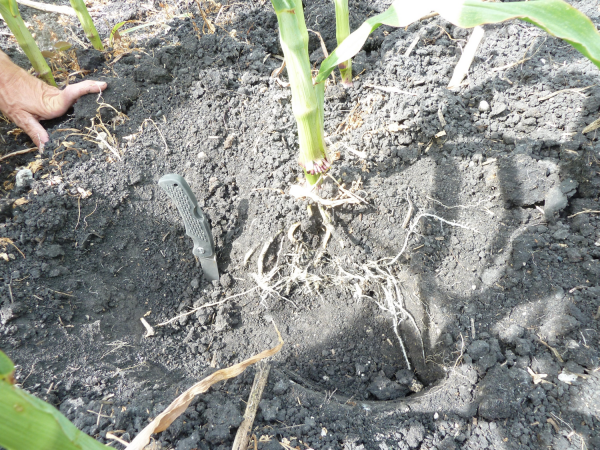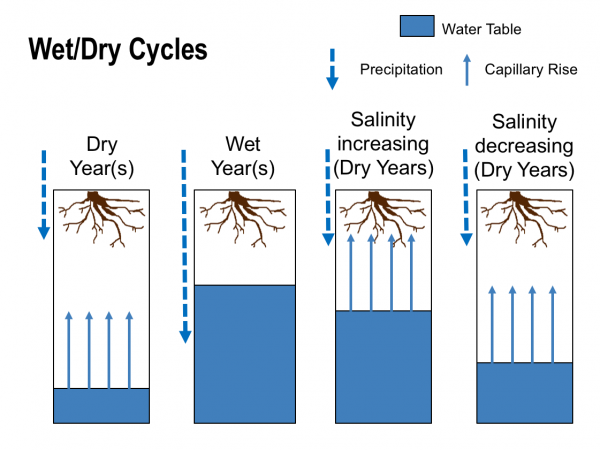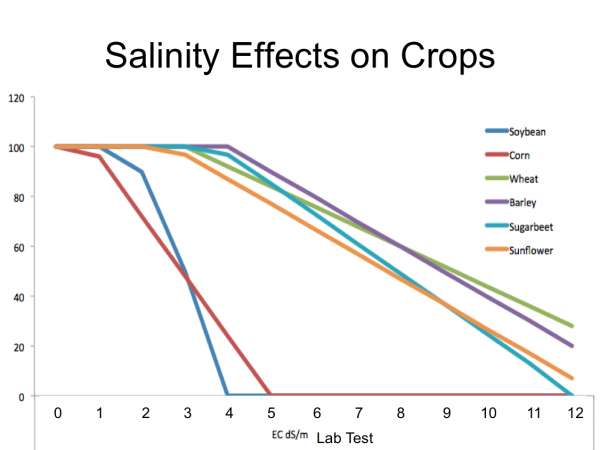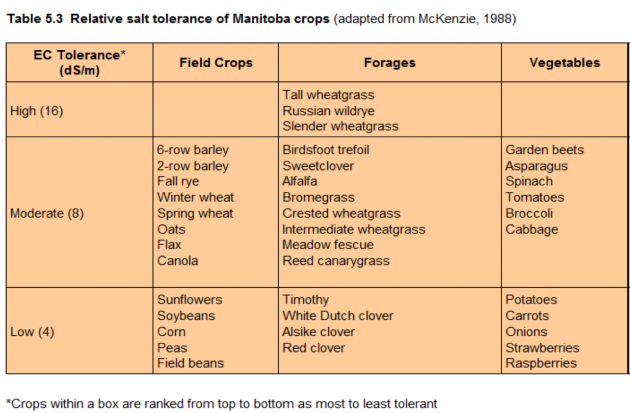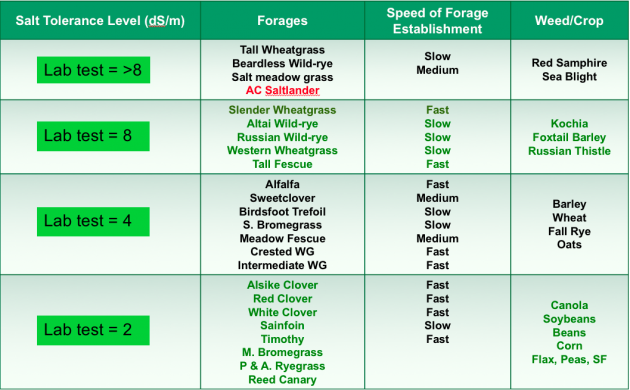
Features
Soil Summit 2019
Soil
Wet/dry soil problems
Compaction, salinity and what needs to be done.
May 28, 2019 By Presented by Marla Riekman, Manitoba Agriculture, at the Soil Management and Sustainability Summit, Feb. 26, 2019, Saskatoon.
Before I get into this concept of wet and dry soil problems, I want to make a couple of definitions clear regarding available water. With very, very dry soil below permanent wilting point, the water attaches tightly to soil particles and is called hygroscopic water. Plants can’t get to this water.
Between the permanent wilting point and field capacity there is capillary waterized pores. This capillary water is held more loosely and plants can access capillary water. Above field capacity the soil is saturated and water is moving down through the profile through those larger pores. This is important because capillary water is plant available water; soil’s water holding capacity is that between field capacity and permanent wilting point.
Field capacity depends on soil texture. The amount of available water increases with clay content because as you have more and more of those smaller pores in clay soils, it’s easier for soil to hang onto water. Sandy soils have very low field capacity because it’s really easy for water to drain through them.
Why do soil texture and available water matter when we’re talking about things like compaction and salinity? They matter because water content is going to affect the risk of things like compaction. It’s going to affect how water moves through the soil, which then influences salinity. If you have wet conditions, during wet years, you have the water table rising towards the surface. This can bring salts up to the surface.
Compaction
When you see wheel tracks across the field, you start seeing things like crop growth issues. Maybe not just this past harvest but years previous, you can start seeing that impact showing up in the crop. You can also look at the root.
I have a penetrometer, which is something that we use to test for resistance or the amount of compaction in the soil. I don’t use it that often because it takes some skill to use it properly.
My favourite tool is called a shovel. I go out, dig around, and take a look at these roots. The roots will tell you what’s going on with the field. So, if you think you have a compaction problem, go dig up some roots. Roots are a little lazy though. They are going to grow into the space they can easily access, and then they’ll start working away within those spaces.
Soil moisture is important when we talk about compaction because if soil is dry, we’re really not at a risk of compacting anything. If the soil is dry, the soil has enough sheer strength, to carry equipment and not slide around. When our soil is really wet, when you’re at that saturation end, we rut the heck out of the field with equipment, but we don’t compact the soil below it because the water is helping to hold the soil in place. It’s helping to hold those pores, but we smear around and mess up the soil structure at the surface, causing ruts.
The problem is when our soils are moist or near field capacity – that point where the big pores have been allowed to drain and that water has moved down, and the small pores are held with water, the big pores have that air, and it’s easier to compact those ones.
Preventing compaction
One of the simple things you can do is to watch your tire pressure. A few years ago, I participated in a University of Minnesota Soil Compaction Day. One of the things they looked at was proper inflation of tires. In the demonstration, a properly inflated tractor tire pushed down about two inches in the soil, but it pushed down 3.5 inches when it was overinflated.
When you check tire pressure, park the tractor on a concrete pad and see if you can get your finger underneath the edge of that on the base of the tire. If you can get even a fingernail under there, you haven’t actually lowered your tire pressure enough. That tire should be contacting as much of that pad as possible. When it gets overinflated, it gets very round. It doesn’t actually impact as wide an area of the soil.
How many of you have heard that tracks are better than tires for compaction? It all depends on your tire inflation. If you have proper tire inflation, there actually isn’t a difference, or much of a difference, between your tracks versus tires. The tracks can have other benefits, like less slippage wetter conditions, but in terms of actual compaction, it’s not as big a difference as we often think as long as those tires are at their rated pressure. Talk to your tire guy, and they’ll be able to tell you what the tire pressure should be set on for your tractor.
The axle load, the weight of equipment, is more difficult to manage. The weight of the equipment is what takes compaction and drives it three to four feet into the ground. When they’ve looked at axle loads for field equipment, they obviously vary, but the load from grain carts is the one that nobody wants to look at. A 1,200 bushel grain cart with one axle carries 35 to 40 tons on one axle. But going with a double axle 1,200 bushel grain cart cuts the load in half. So, more axles are beneficial in this case because you’re really lessening some of that overall impact.
Have you also heard that 80 per cent of compaction happens in the first pass? When this was studied, the researchers drove over the same tracks four times in a row. On the fourth pass, they called that 100 per cent of compaction. Eighty per cent of that total compaction happened the very first pass that they went across the field. So, during harvest, if you’re dealing with compaction, you might want to head on to the field with the grain cart on the same track and then veer off where you need to in order to catch up with the combine.
All that compaction happening in the first pass is also the reason why we start talking about things like controlled traffic farming, or at least being more deliberate and planning where you’re going to travel on the field.
Dealing with compaction
If your soil is already compacted, what am I going to do? Can deep tillage break it up? We have research in Manitoba that looked at decreasing compaction over time using a subsoiler. The subsoiler was able to alleviate deep compaction to a certain extent, but over time, when they tested again, one year and then two years after the subsoiling had been done, the soil re-compacted. Subsoiling isn’t a long-term fix if we continue to add compaction back into to the mix.
Subsoiling is not a cheap thing to do. It takes a lot of horsepower and a lot of fuel to pull those deep shanks up and down the field. In Iowa, where they do this a bit more commonly, they looked at a farm trial where they split the field in half. One-half of the field was subsoiled, and the other half of the field wasn’t. They often did get a yield benefit, but they didn’t make enough money off of that little bump in yield to have paid for the cost of subsoiling. Half of the time they made it; half of the time they lost money on doing it. From this trial, they concluded that maybe subsoiling should just going to stick to the bad stuff, stick to the headlands, stick to the soils that really need the work, and leave the rest of it alone.
If you’re going to subsoil, there are a couple considerations. The first is going about an inch underneath the compacted zone. You also want to time the subsoiling operation when the soil is quite dry. A lot of research shows that subsoiling at permanent wilting point is when you get the best kind of fracturing and shattering of the soil. If the soil is wet you just kind of slime through it, and you just leave the slot open. It doesn’t do anything when it’s really wet. A lot of the problem that we’ve been seeing in Manitoba is people want to subsoil, but it’s never dry enough in the fall to effectively subsoil. So, you can cause issues if you’re actually running it through wet soil.
On a lot of the clays that we have in our soils, especially in the Red River Valley, and these clay soils have this shrinking/swelling capability. They open up with dry conditions, and then they seal closed again when it’s wet. When you get down to permanent wilting point, most likely the soil has actually cracked open on its own, and then the question is, “Why do I need to subsoil if the soil already did it for me?” This is alleviating compaction, breaking it up over time. So, wetting and drying is really important in this case.
Cover crops have the potential to alleviate compaction. But I have seen tillage radish grow down and then sideways on heavily compacted soils. Cover crops can, however, reduce susceptibility to compaction, by drying out the soil. The success depends on the species. It depends on the root type. By using cover crops, we’re adding different roots into our crop rotation, potentially creating bio-pores, creating spaces left behind by those decaying roots for new roots to actually move through and grow into. All of that works over a long period of time to help break up compaction. However, if we add tillage on top of cover crops, we can mess up all of those bio-pores that were left behind by the roots.
Controlled traffic farming is another approach to compaction. It creates permanent tramlines in the field. So instead of randomly trafficking across the field you are creating a roadway in your field every 40 feet, or whatever the multiple width is for the equipment that you own. You’re creating that roadway that will be quite compacted, but that’s okay because you’re not compacting the rest of the field.
Understanding salinity
When we talk about salt, salinity is not a salt problem. It’s actually a water problem. If you remember nothing else, remember that salinity is all about where water is moving in the soil. Is it moving up? Is it moving down?
Downward water movement means you should not have salinity because downward water movement means salts are going down. Upward water movement is a problem because it can bring salts to the rooting zone.
So, when you’re dealing with conditions that are going to cause you salinity there are three main points. High water table that can be within six feet of the surface that carries soluble salts in to the root zone by capillary rise is the first point. Then you need high evaporation rates that exceed infiltration. And the third thing is a plant that is susceptible.
I’ve mentioned that soybeans and corn are weaklings when it comes to salinity. A lot of our small grains and oilseeds can tolerate a lot more salinity before they start seeing yield loss. Then when you do start seeing yield loss, it tapers off a lot longer.
There are a number of different places where salinity shows up. Basically, what’s happening is where your water table is coming closer to the soil surface and that capillary rise takes over, then that’s where those salts are coming up. Bathtub ring salinity becomes really common in areas where there are wetlands or sloughs. You can see this ring of salt or salinity all the way around.
There were some wetlands, however, that do not have any salinity at all. Those places, those wetlands, are the ones that still have willows growing around them because the willows were sucking up the water. They were intercepting the water that was moving out and drawing the salts with them.
Diagnosing salinity
To diagnose salinity, you want to look at your electrical conductivity (EC). Soil tests at zero to six-inch and six to 24-inch depths will measure EC. You can also map fields with EM38 or a Veris or some other technology that measures EC. Electrical conductivity is an indirect measure of salt. Electrical conductivity will also change with things like moisture content, clay content, and when soils are frozen. So, if you’re using a mapping unit for electrical conductivity, you have to still calibrate it with soil samples.
This is probably the most frustrating thing that I have to deal with when we talk about things like salinity is that the units. Measurements can be expressed as deciSiemens per metre, milliSiemens per centimetre, and millimhos per centimetre. The unit doesn’t matter because the number is the same.
There are two different methods of analysis for salinity that can be done in the lab. The one that you get done at a commercial lab is called a 1:1 mix of water and soil. It’s easy. The labs love it and it is cheap.
The saturated paste test is used by researchers and the Soil Survey Lab. They take the soil and mix just enough water in to get a paste consistency. They put it in a filter and draw the water off, and then they test that water. It takes longer and costs $20 more. The result is double the number that you get from the 1:1 test. So, if you’re looking at research data telling you what the crop tolerance is, you have to take that number and divide it by two in order to compare it to what you have for a soil test. It’s the only reason I bring it up. It is the most confusing thing about this.
Managing salinity
You can’t fix salinity but you can manage it. You’re going to manage the water table to the best of your ability because it’s a water problem, not a salt problem.
The first thing to do is look at your yield map. You’ll know exactly where your saline patches are, usually in the lower lying areas of the landscape. Stop spending money on them. It’s the simplest thing you can do. If you’re going to seed through them every year turn off the fertilizer tank. You’re not growing a crop.
Second thing I want you to do is consider investing in those saline spots. This is where the planning comes in. Soil sample those areas and see how bad to decide what kind of forage or crop you can actually grow in those spaces.
If you have a high water table that allows those salts to come up, then a solution might be to lower the water table. You can use crops that suck up a lot of water. Use that to your advantage. You can look at something like tile drainage. If you have a high water table and have the ability to tile, then that potentially can lower salts in the soil.
Keep the soil covered. Tillage is probably one of the worst things you can do in those saline patches because it just causes more evaporation and brings water to the surface.
Choose crops strategically. Plant a high water-using crop in the non-saline areas and a saline-tolerant crop in those areas that have a lot of salinity in them. This, I get, is not an easy thing to do because a lot of times those saline patches are in the middle of the field.
You can get your weeds working for you. What weeds do you normally have growing in your saline patches? Kochia? Foxtail barley? I have farmers who have said they have started mowing their weeds because they don’t want them to go to seed. Don’t till the area. Don’t spray it out. Something is actively growing and taking up water, and they’re transpiring water, and it is helping to lower the water table in that area. It’s kind of like the low-hanging fruit, the easiest thing. You can use weeds to your advantage.
The other thing you might want to do is plant a buffer crop. If you’re dealing with something like roadside salinity, what about planting a deep rooted alfalfa right on the edge of the field that taps down and starts using up that water and decreases the level of saline creep that moves into the rest of the field?
Plant saline-tolerant crops. We have things like AC Saltlander that has a very high level of salt tolerance, and what I understand, it is more palatable. So, if you’re looking at feeding some of these forages, some of them, the salt-tolerant ones, don’t have as good feed quality, but Saltlander apparently is a little bit better.
When managing something like salinity, I want you to be sceptical of quick fixes. There is no special product out there that you can spray on the soil that’s going to fix your salt because salt problems are water problems. Managing salinity is all about managing water.
More from the 2019 Soil Summit
Watch Marla Riekman break down the major factors contributing to compaction and salinity and ways for farmers to manage both in her Speaker Spotlight video. To see other presentations and speaker spotlight videos, visit our archives for the 2019 Soil Management and Sustainability Summit.
